Asteroseismologists are combining data from TESS, Kepler, and eventually, JWST to study stellar oscillations in ‘infant’ stars, with the goal of creating new models for how such young stars form and evolve over time. Plus, JWST images Mars, Hubble images stars, and SpaceX manages to launch another Starlink mission in spite of weather delays.
Podcast
Show Notes
JWST observes Mars very carefully
Missing ancient Martian lakes in the data
- The University of Hong Kong press release
- “Geological diversity and microbiological potential of lakes on Mars,” Joseph R. Michalski et al., 2022 September 15, Nature Astronomy
Enceladus’ oceans host habitable components
- SwRI press release
- “Abundant phosphorus expected for possible life in Enceladus’s ocean,” Jihua Hao et al., 2022 September 19, PNAS
Being a star: nature vs nurture
- University of Innsbruck press release
- “The imprint of star formation on stellar pulsations,” Thomas Steindl, Konstanze Zwintz, and Eduard Vorobyov, 2022 September 19, Nature Communications
Hubble captures an unusual spiral galaxy
- NASA image release
Hubble captures a complicated globular cluster
- NASA image release
What’s Up: Week of 9/19/22
Falcon 9 dodges weather to send 61st Starlink mission into orbit
- Starlink mission page (SpaceX)
Solar phenomenon finally captured on camera
- ESA press release
- “Observation of a Magnetic Switchback in the Solar Corona,” Daniele Telloni et al., 2022 September 12, The Astrophysical Journal Letters
Anniversary of Iconic Voyager 1 photo
- Crescent Earth and Moon (NASA JPL)
Transcript
Today’s show is one that has made me reflect on just what it takes to understand our universe. More than 2,000 years ago, Plato advocated for teaching our leaders astronomy and said, “Astronomy compels the soul to look upwards and leads us from this world to another.” Basic Astro classes teach the discoveries of Eratosthenes in 200 BCE that led to a pretty accurate measure of Earth’s radius.
Astronomy is an OLD field of research, and yet, our discoveries only advance as our technology to travel, to look up, and to model our results all improve.
Yes, I said travel. Astronomers have been traveling the globe to catch eclipses and other astronomical events for at least a couple hundred years.
Today, we have stories of researchers looking with the newest instruments at Mars and Enceladus as they work to understand what Earth-tested science may apply on these very different worlds. We look at oscillating baby stars and try to understand how they will grow up to shine, and we share Erik and SpaceX’s frustration with the weather in Florida and how it likes to keep good rockets down.
All of this and more is coming to you today on the Daily Space. I am your host Dr. Pamela Gay, and we are here to put science in your brain.
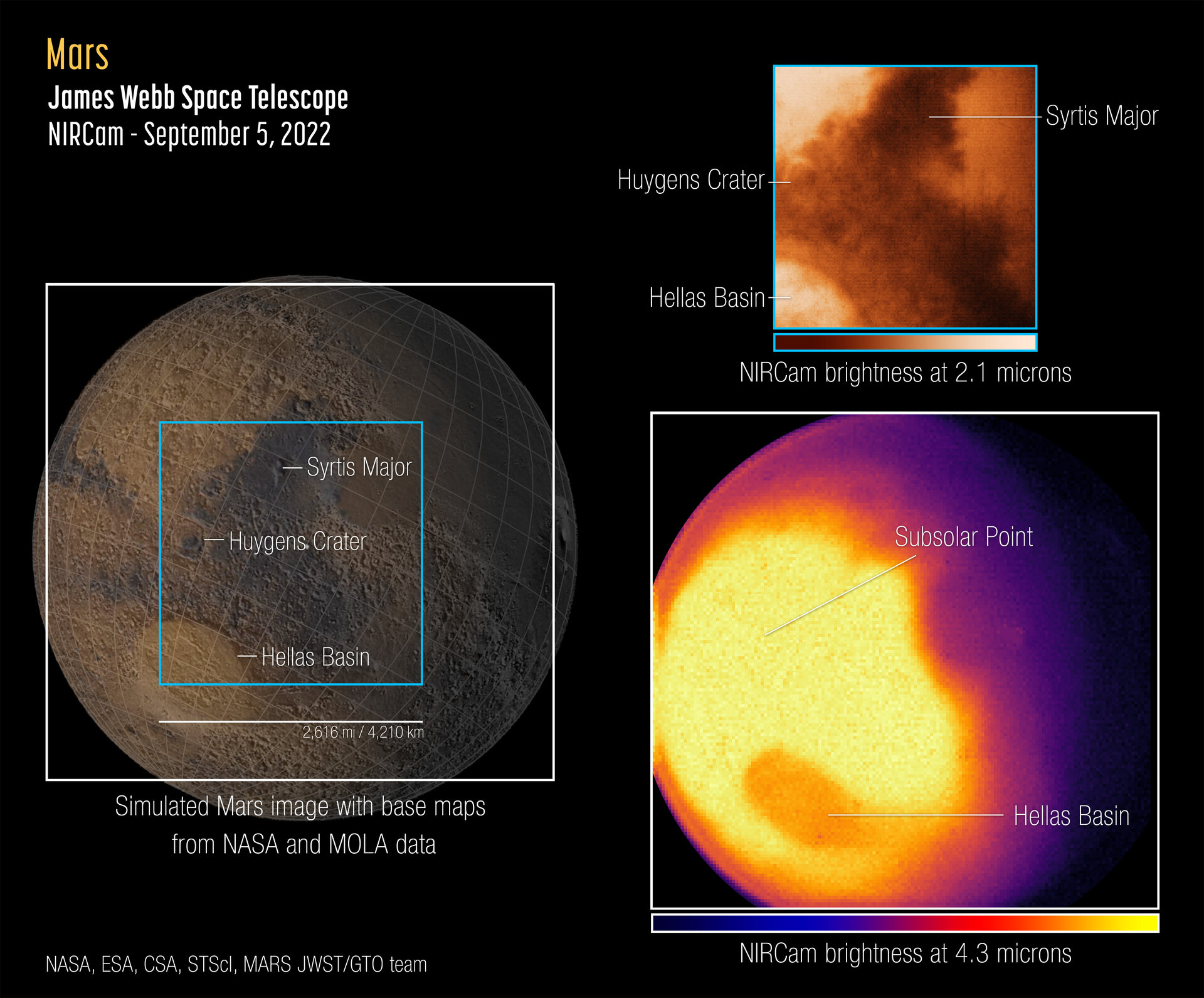
If it feels like we’re getting a lot of “JWST does something for the first time” stories this year… it’s because we are. This week, the newest images are of Mars. Once again, they have tracked JWST to look inside our solar system, just as they did with Jupiter last month.
And what they managed to capture was a portion of Mars’s eastern hemisphere in two different infrared wavelengths. Two images have been released along with a reference map collected by NASA and the Mars Orbiter Laser Altimeter. The smaller, more orange image is dominated by reflected sunlight collected at 2.1 microns and matches up to the visible-light version. The longer wavelength version – collected at 4.3 microns – is a product of the planet’s thermal emission or heat. That image shows which regions of the red planet were receiving the most sunlight at the time of the observation. You can see the images in our show notes at DailySpace.org.
In addition to the infrared images, JWST also collected a near-infrared spectrum of Mars. While that spectrum is still being analyzed, the initial release shows the presence of carbon dioxide, carbon monoxide, and water vapor. Further data is expected to be collected in the future that will allow for a detailed analysis of Mars’s atmosphere including regional differences and trace molecules like methane and hydrogen chloride.
We here at the Daily Space are particularly interested to see these global views on methane.
These images and the spectrum have not been put through the peer review process, yet, but we’ll bring updates once the relevant papers make it to press.

While JWST seems primed to help understand Mars’s current atmospheric conditions, a new paper published in Nature Astronomy with lead author Joseph R. Michalski contends that we are vastly underestimating just how many lakes there were back in Mars’s more watery period.
Estimating the number of lakes on Mars is important to understanding how the planet changed over millennia on both large and small scales. Michalski explains: We know of approximately 500 ancient lakes deposited on Mars, but nearly all the lakes we know about are larger than 100 km2. But on Earth, 70% of the lakes are smaller than this size, occurring in cold environments where glaciers have retreated. These small-sized lakes are difficult to identify on Mars by satellite remote sensing, but many small lakes probably did exist. It is likely that at least 70% of Martian lakes have yet to be discovered.
Additionally, all these lakes likely only lasted a geologically brief time – about 10,000 to 100,000 years. And this new paper dates those lakes back to 3.5 to 4 million years ago, which gives a pretty narrow window for the development of life. On top of that issue, Michalski notes: Because of the lower gravity on Mars and the pervasive, fine-grained soil, lakes on Mars would have been very murky and might not have allowed light to penetrate very deeply, which could present a challenge to photosynthetic life, if it existed.
None of this means we should give up hope of finding that evidence. We have managed to find life in the wildest of environments here on Earth, including deep underground and in sulfur ponds. Mars isn’t outside the realm of possibility, but we’re going to have to keep searching, and we may need to search for those smaller lakes, too.
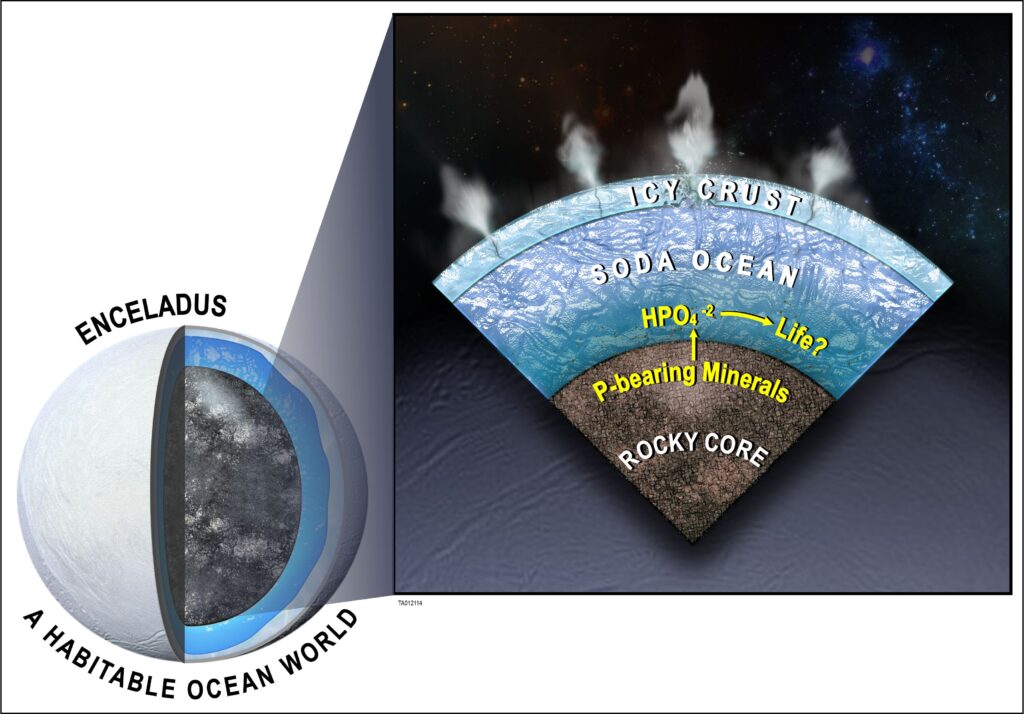
“Follow the water” is the theme of much of our quest to find life beyond Earth. From narrowing down the so-called Goldilocks zone to where water can be liquid to the discovery of subsurface ocean worlds, we have pinned our hopes on finding what we recognize as life. Now, scientists led by Jihua Hao have published new models for the composition of the subsurface ocean on Saturn’s moon Enceladus and have determined that a key ingredient – phosphorus – should be readily available. [The paper is published in the Proceedings of the National Academy of Sciences.]
Phosphorus is important for the creation of DNA and RNA, the formation of cell membranes, and even bones and teeth in all manner of animals. Up until recently, much of the data analyzed from the Cassini mission couldn’t prove that phosphorus was contained within that subsurface ocean. So this team of researchers worked up some new thermodynamic models that simulated the water’s geochemistry using that Cassini data. It turned out that phosphate minerals would be “unusually soluble”.
Co-author Christopher Glein notes: The underlying geochemistry has an elegant simplicity that makes the presence of dissolved phosphorus inevitable, reaching levels close to or even higher than those in modern Earth seawater. What this means for astrobiology is that we can be more confident than before that the ocean of Enceladus is habitable.
All we need is a mission to Enceladus.
Coming up, how stars ignite nuclear fusion and some new images from Hubble.
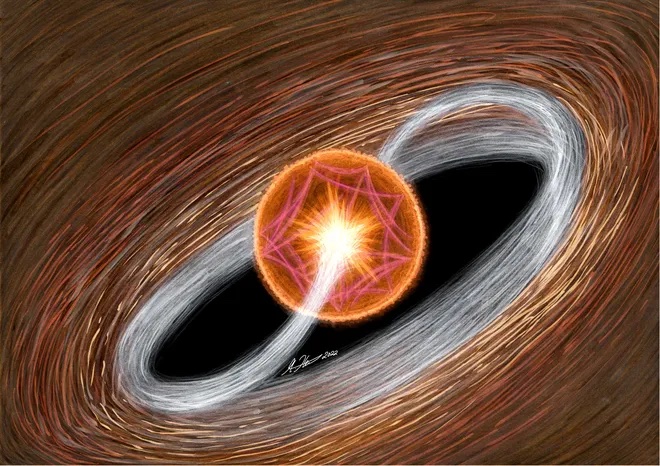
This next story left me wondering what “young” means in astronomy. It’s about trying to understand the lives of stars prior to that point where stable nuclear reactions begin in their cores. This work is led by Konstanze Zwintz, who is described as a leader in the “young” field of astroseismology.
When I was a youngling at Michigan State University, we learned about the then new field of astroseismology my senior year, which, somehow, was more than 25 years ago. In computer science that would make astroseismology a mature field of research, but in astronomy, where our New General Catalogue of objects was first published in 1888, astroseismology is pretty much a toddler learning to run, while fields like exoplanetary research are just starting to sit up.
Anyway, in the toddling field of asteroseismology, researchers like Zwintz and his colleagues are combining data on stellar oscillations in infant stars from TESS and Kepler, and looking forward to data from JWST, and using these oscillations they are developing computer models that look at how the interior of these object change as they form, condense and eventually ignite. I love this research because it uses concepts I’ve used in my research in elder stars in a totally new way.
Thomas Steindl, a member of Zwintz’s group, explains: Research on stars has so far focused mainly on adult stars – such as our Sun. Even if it sounds counterintuitive at first glance, so far little attention has been paid to the evolution of the pre-main sequence because the phase is very turbulent and difficult to model. It’s only the technological advances of recent years that allow us a closer look at the infancy of stars – and thus at that moment when the star begins to fuse hydrogen into helium.
Asteroseismology and the study of pulsating stars both share a basic concept: They look at how a star vibrates like a tuning fork in response to various forces. These vibrations are directly related to the volume and density of the material they are passing through. While senior stars like the variable ones I looked at may have simple pulsations that expand and contract entire stars, asteroseismologists look at complex waves that look more like vibrations of an orchestra on the head of a speaker horn, and each of the different waves can reflect different resonances in the star.

Steidl goes on to explain: The classical theory assumes that the time before ignition is simply irrelevant. This is not true: Comparable to a musical instrument, even subtle differences in the composition lead to significant changes in the tone. Thus, our modern models better describe the oscillations in real stars.
This is amazing work, and it is a lifetime of work. Team leader Zwintz explains: I was already convinced about 20 years ago, when I first saw the oscillation of a young star in front of me on the screen, that I would one day be able to prove the significance of early stellar evolution on the ‘adult’ star. Thanks to the great work of Thomas Steindl, we have now succeeded: Definitely a eureka moment for our research group and another milestone for a better understanding of the growth steps of stars.
It is amazing to watch both a star and a research field get all grown up.
Astronomy is an old field. Thanks to centuries of observations astronomers have come up with categories for different types of galaxies. Still, like most of the neat little boxes humans make, some things fall out.
One such object is NGC 1961, which is an intermediate spiral galaxy with an active galactic nucleus. It has spiral arms but lacks the bars of a barred spiral type. Instead, its stars are in a big pile at the center, much brighter than the rest of the galaxy. NGC 1961 likely has a supermassive black hole at its center, which affects the evolution of its population of stars and shape by sending large jets of charged particles into and through the galaxy.

One of the things Hubble was designed to look for was the observation of individual stars in globular clusters as a way to gain insight into the evolution of these systems. Globular clusters at the center of our galaxy have been hard to study because of the large amounts of gas and dust blocking our view. The process of an object dimming to the point of becoming undetectable due to dust or gas is called extinction, and it happens a lot when we look toward the center of the Milky Way.
Now, however, combining data from two Hubble instruments and new processing techniques has allowed scientists to un-extinct globular clusters and even determine the age of some of them. One such globular cluster is named Terzan 4. Thanks to the new method, Terzan 4’s age has been determined to within a billion years. Considering an order of magnitude is a good measurement in astronomy, that’s a relatively precise age for this cluster.
For those listening to our podcast, we’ll have the images in our show notes at DailySpace.org.
What’s Up
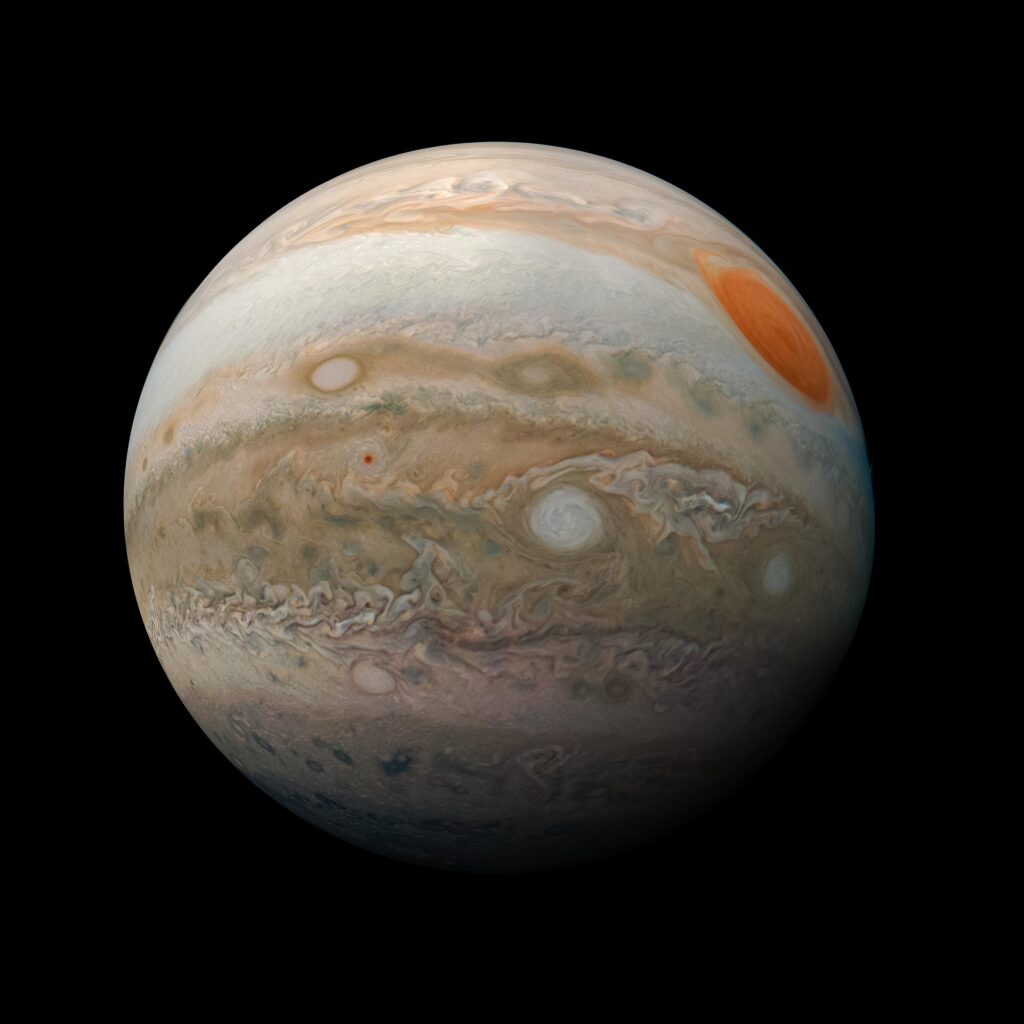
We’ve had a packed news show today and we’re not quite done but I wanted to briefly mention that Jupiter will be at opposition this coming week, specifically on Monday, September 26th, but it will also be nearly as high and bright for a few days before and after opposition proper. Opposition is when the Earth is directly between a planet and the Sun, meaning it is fully illuminated as seen from Earth. This opposition marks Jupiter’s closest approach in 70 years, so its apparent size will be larger as well.
Go outside and look up, but … maybe wait until we’re done with the show?
Still to come is an update on a weather-plagued rocket, a look at Solar Orbiter, and a look back at Voyager 1.
Rockets and Spacecraft
In a sign that the seasons have finally changed, SpaceX launched their latest Starlink mission from SLC-40 on the space coast on the 5th attempt. The mission was aborted just before launch several times due to weather and barely escaped Earth on September 19th in between storms. We at CosmoQuest hosted live watch parties on Twitch for several of the attempts and were relieved when it finally lifted off.
The Eastern Range Weather Officer predicted a 60% chance of violation of weather constraints for the attempt, but Starlink 4-34 made it! And just in time, because Hurricane Fiona is in the Atlantic and could have kept the mission on the ground even longer.

Launch weather constraints are very important for rockets to safely deliver their payloads. Flight through possible lightning conditions is the most significant factor, as a rocket getting struck by lightning can cause damage to its structure and computers, causing control problems. Flight through an area of rapidly changing wind directions, known as wind shear, is also important to avoid as this can also cause control problems, especially for the very tall and thin Falcon 9 rocket.
Active weather systems that lead to violations are often present during the Atlantic hurricane season which runs from June to November and is most active in September, so it is unsurprising that this launch had so many aborts. Those in the online space community have taken to calling this month Scrubtember… and next month Scrubtober.
We’ll see how all this weather bodes for the next launch attempt of NASA’s Space Launch System, currently set for no earlier than September 27. As of press time they have not received the critical waiver from the Range about the batteries in the rocket’s flight termination system. The Range does not budge on public safety, and it is unlikely that NASA will get the waiver. This will delay the launch into October as the rocket must be rolled back into the Vehicle Assembly Building to replace the batteries.
But I digress…
In case you are confused by SpaceX’s bewildering and ever-changing designations for their internal Starlink missions, this was the sixty-first launch of Starlink satellites since May 2019.
While it’s not Friday, here are some statistics. Booster 1067 completed its 6th flight by landing on the drone ship Just Read The Instructions after sending the second stage on its way to orbit. This was the 135th landing of a Falcon 9 first stage, 96th launch from SLC-40, and 180th SpaceX launch overall. SpaceX continues to break their own record for launches in a year, this was the 42nd.
The 54 Starlink satellites were deployed into the standard slightly eccentric deployment orbit after one burn of the upper stage. Later on in the mission’s very first orbit, the Falcon 9 second stage turned around and sent itself into the Pacific Ocean south of Australia.
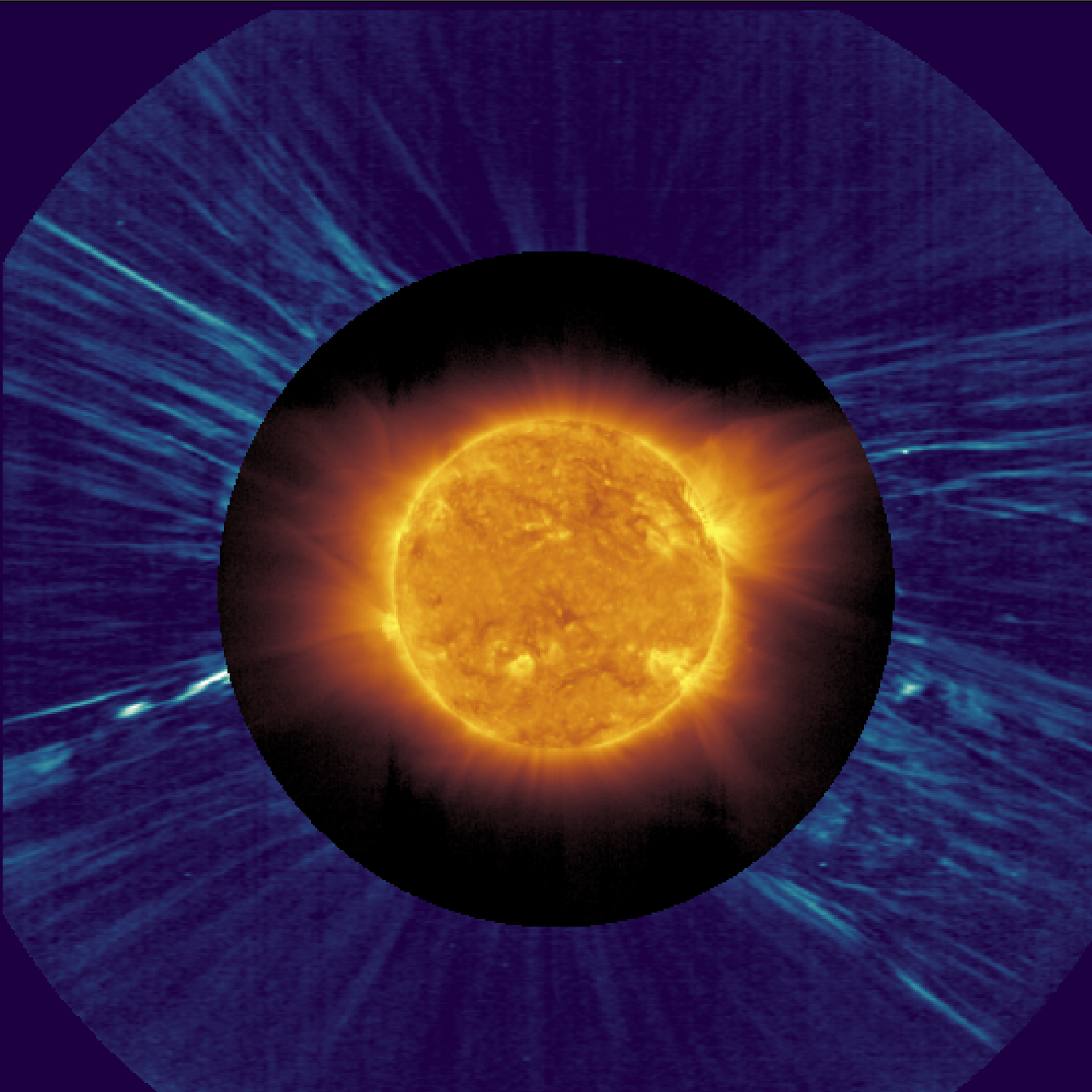
And that – so far – is all the rocket launches we’ve had this week. While these next stories aren’t technically rocket launches or What’s Up – the things I normally talk to you about – Imma bring you joy with a bit of good news… or at least good images… from Solar Orbiter and Voyager 1.
First up, the European Space Agency’s Solar Orbiter captured its first image of a “solar magnetic switchback”. Solar Orbiter was designed to observe the Sun from a distance working in combination with NASA’s Parker Solar Probe, which will get as close as possible with current technology. Solar Orbiter studies the corona and solar wind, and over years of Venus gravity assists, will change its orbit to explore the Sun’s poles as well.
A magnetic switchback is the “sudden reversal of the solar wind’s magnetic field”. It presents as an S-shaped bend of plasma. Such events may be part of the reason the solar wind spreads far into the solar system and affects interplanetary space. According to paper first author Luca Sorriso-Valvo, magnetic switchbacks “have been measured in situ [by spacecraft] for but still poorly understood. We hope to be able to observe other similar structures soon to unveil their nature”.
The work was published in the journal Astrophysical Journal Letters.
Finally, we have one anniversary to mention.
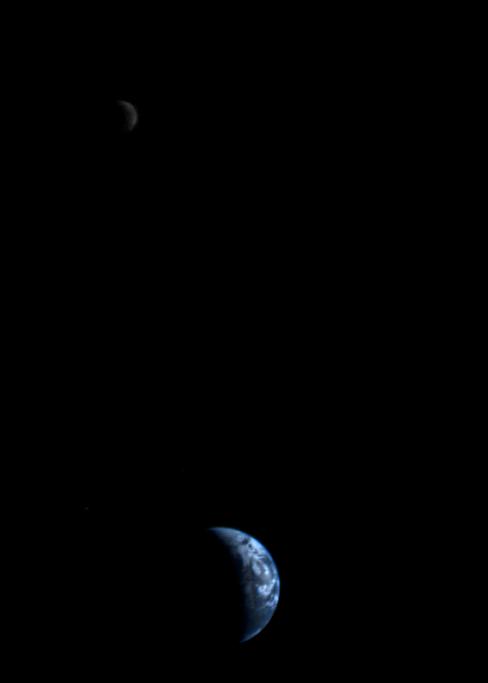
Voyager 1 has spent decades in space sending back images of Jupiter and Saturn, including the classic Pale Blue Dot image of the entire solar system, before the spacecraft’s cameras were shut down to save power. But before all of that they had to be tested.
So two weeks after launch, on September 18, 1977, Voyager 1 looked back from a distance of 11.6 million kilometers and took a picture showing both the Earth and the Moon. The three-filter composite was shot to properly expose the Earth. The Moon was brightened in post-processing so both would be visible.
We’ll have the full images for Voyager and Solar Orbiter in the show notes so you can take a closer look.
For now, though, this has been the Daily Space.
You can find more information on all our stories, including images, at DailySpace.org. As always, we’re here thanks to the donations of people like you. If you like our content, please consider joining our Patreon at Patreon.com/CosmoQuestX.
Credits
Written by Pamela Gay, Annie Wilson, Beth Johnson, Erik Madaus, and Gordon Dewis
Hosted by Pamela Gay, Beth Johnson, and Erik Madaus
Audio and Video Editing by Ally Pelphrey
Content Editing by Beth Johnson
Intro and Outro music by Kevin MacLeod, https://incompetech.com/music/


 We record most shows live, on Twitch. Follow us today to get alerts when we go live.
We record most shows live, on Twitch. Follow us today to get alerts when we go live.